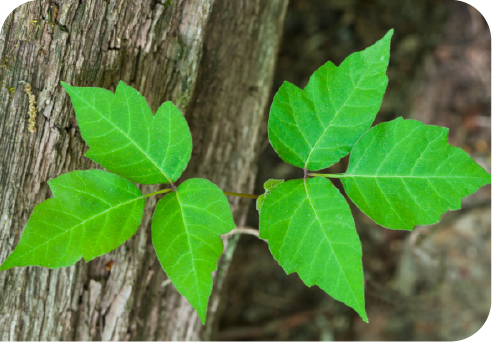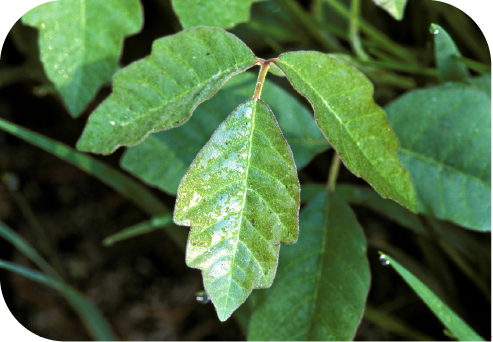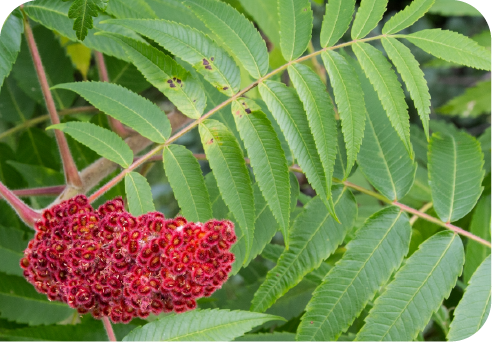Ditch the itch! How to avoid poisonous plants

Summer is here, and the fresh air is calling! Maximize your enjoyment of the great outdoors by protecting yourself from irritating itches and rashes.
Poisonous plants may be present where you least expect them. And, there are three in particular that seem to be most prevalent. Learn how to spot them and what to do if you get exposed.
Be aware of the triple threat
Poison ivy, poison oak and poison sumac are three common plants. If you touch any of these plants, you could get an itchy skin rash. The rash comes from an allergic reaction to the oil, urushiol. It’s the common enemy found in each of these plants.1
You can even get exposed to urushiol from your pet. This happens if you touch a cat or dog after they have rubbed up against one of these poisonous plants. If your dog or cat has come into contact with the oil, bathe them right away. And, make sure you wear rubber gloves when you do.1
Getting into the weeds
We’ll go over what you need to know about poison ivy, poison oak and poison sumac in a little more detail. If you already have a skin issue, you can use our dermatology service to get quick help.

What to know about poison ivy
Poison ivy is a shrub or a vine. These can climb on other plants and trees or trail along the ground. Poison ivy can have small whitish flowers or berries. It grows in nearly all parts of the U.S.
To identify poison ivy, you can remember the saying, “Leaves of three, let them be.” Each leaf of the plant has three leaflets that look shiny or glossy. The leaves turn red in the spring, green in the summer and yellow, orange and red in the fall.1, 2

What to know about poison oak
Poison oak has three leaflets with rounded tips. The leaves’ edges appear scalloped and fuzzy.
It usually grows as a shrub in the Eastern U.S. and the South. The shrub may have white or yellow berries. In the Western U.S., poison oak appears more often as a vine or a tall clump.1, 2

What to know about poison sumac
Poison sumac is a tree or tall shrub. Each leaf has from seven to 13 smooth leaflets that change colors with the seasons. You can find poison sumac in the swampy areas of the Northeast, Midwest and parts of the Southeast. It also has drooping clusters of yellow, cream or green flowers or berries.1, 2
Symptoms
Symptoms of poison ivy, poison oak and poison sumac are usually the same:
- An itchy rash
- Fluid-filled blisters
- Redness and sometimes swelling
You may start experiencing symptoms anywhere from a few hours to several days after being exposed to the plant.1
What to do if you have symptoms
- Wash and rinse your skin with soapy, lukewarm water as soon as you can (rubbing alcohol can also help)
- Wash your clothes and everything that touched the plant
- Don’t scratch! And, leave blisters alone
- Use cool compresses, take short, lukewarm showers or baths and use calamine lotion to help with irritation1
- Get emergency care right away if you have a hard time breathing or swallowing, a rash or swelling around your eyes or mouth, severe itch that prevents sleep, a fever or a rash that covers a large area of your body1
If your rash does not get better or go away within a week to 10 days, contact your primary care provider. Or, you can use our General Medical service for non-urgent conditions. Connect with us 24/7 by phone or video to get quality care from licensed healthcare professionals.
You can also use our dermatology service to quickly find out whether a skin issue is poison ivy, poison oak or poison sumac.
How to use Teladoc Health Dermatology:
- Upload photos of your skin issue Start an online review with a board-certified dermatologist to get help for rashes, sunburns, skin infections, moles and more. No video or phone call with the doctor is needed.
- Get a custom treatment plan in 24 hours or less Receive your dermatologist’s diagnosis and treatment plan via your Teladoc Health messaging center. Prescriptions, if needed, can be sent to your pharmacy of choice.
- Ask a follow-up question, if needed Send a follow-up message to your dermatologist online or in the Teladoc Health app for up to 7 days after your review.
Find out more ways to care for your skin this summer.
1https://www.aad.org/public/everyday-care/itchy-skin/poison-ivy
2https://www.fda.gov/consumers/consumer-updates/outsmarting-poison-ivy-and-other-poisonous-plants
Was this article helpful?
Don't wait! Unlock a healthy, happy new year, at no cost to you.
This content is not intended to be a substitute for professional medical advice, diagnosis or treatment. Always seek the advice of your physician or other qualified health provider with any questions you may have regarding a medical condition.
